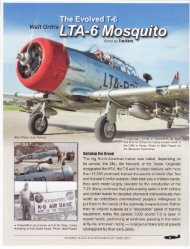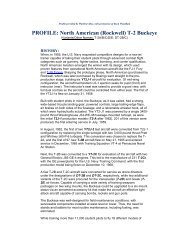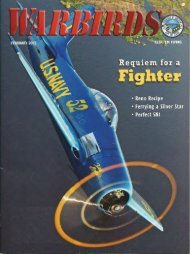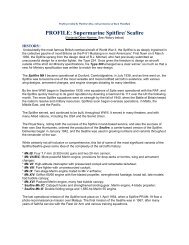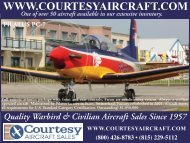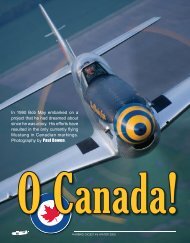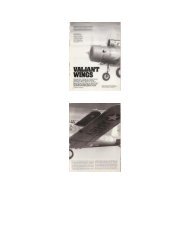To Read Sport Aviation's January 1990 Ed on the ... - Courtesy Aircraft
To Read Sport Aviation's January 1990 Ed on the ... - Courtesy Aircraft
To Read Sport Aviation's January 1990 Ed on the ... - Courtesy Aircraft
- No tags were found...
You also want an ePaper? Increase the reach of your titles
YUMPU automatically turns print PDFs into web optimized ePapers that Google loves.
·eight, c<strong>on</strong>siderably more power<br />
- ::e needed than <strong>the</strong> 85 hp of <strong>the</strong> Eris<br />
calculati<strong>on</strong>s worked out, it was<br />
...s t his 2-place flying automobile<br />
-eq ire about <strong>the</strong> same power as a<br />
ace lightplane ... 140 to 150 hp.<br />
er would have to accept <strong>the</strong><br />
<strong>the</strong> cost of <strong>the</strong> extra power for<br />
o having a car capable of flight.<br />
-..-,..,..nUllO to Molt, when he and his en-<br />
- sat down and began to develop <strong>the</strong><br />
::<strong>on</strong> urati<strong>on</strong>, <strong>the</strong> Aerocar more or less<br />
_:-ed itself. They knew that <strong>the</strong> public<br />
accept anything radically different<br />
- car porti<strong>on</strong>, especially with regards to<br />
. so <strong>the</strong> wing had to be positi<strong>on</strong>ed so<br />
- ,., as as unobtrusive as possible. That,<br />
, dictated a high wing mounted as<br />
- - as possible. They also felt that <strong>the</strong><br />
ould object to having to remove <strong>the</strong><br />
:r:oe er, as was necessary with <strong>the</strong> Fult<strong>on</strong><br />
·an, in order to use <strong>the</strong> car porti<strong>on</strong> <strong>on</strong><br />
way, so that plus several o<strong>the</strong>r lac-<br />
"' ... forward visibility, weight distributi<strong>on</strong>,<br />
:x::essive heat in <strong>the</strong> cockpit, etc .. .. made<br />
decide <strong>on</strong> placing <strong>the</strong> engine behind<br />
:oe seats, almost <strong>on</strong> <strong>the</strong> aircraft C. G., and<br />
opeller at <strong>the</strong> end of a l<strong>on</strong>g tail c<strong>on</strong>e.<br />
-:: ovide adequate prop clearance for rotatake-off,<br />
<strong>the</strong> tail c<strong>on</strong>e would have to<br />
:e angled up c<strong>on</strong>siderably .. . but, fortui-<br />
,. , in <strong>the</strong> right directi<strong>on</strong> for overcoming<br />
e atural pitching moment of <strong>the</strong> wing .<br />
-- . in turn, dictated <strong>the</strong> detaching of <strong>the</strong><br />
arid tail c<strong>on</strong>e as <strong>on</strong>e unit .. . which<br />
wed <strong>the</strong> folding back of <strong>the</strong> wings and<br />
of <strong>the</strong> flight porti<strong>on</strong> of <strong>the</strong> vehicle bee<br />
car like a trailer. The c<strong>on</strong>figurati<strong>on</strong><br />
e tail also more or less fell into place. A<br />
enti<strong>on</strong>al vertical tail would have caused<br />
:::e:arance problems in garaging <strong>the</strong> Aerocar,<br />
s:: a "Y" tail was <strong>the</strong> logical soluti<strong>on</strong>. A wel<br />
::o-:led side effect was <strong>the</strong> fact that bottom<br />
e positi<strong>on</strong>ing of <strong>the</strong> vertical tail served to<br />
agel)' offset adverse yaw . . . and was a<br />
r in making <strong>the</strong> Aerocar spirally stable.<br />
off, <strong>the</strong> craft would eventually enter a<br />
w turn, <strong>the</strong>n recover <strong>on</strong> its own . . . insaad<br />
of winding up in a classic graveyard<br />
• as c<strong>on</strong>venti<strong>on</strong>al aircraft are pr<strong>on</strong>e to<br />
Some earlier roadable aircraft, such as<br />
Waldo Waterman's Aerobile, had just 3<br />
wheels, but, again, Molt and his team felt<br />
this deviati<strong>on</strong> from normal automotive practice<br />
would be a detriment to <strong>the</strong> acceptance<br />
of <strong>the</strong> vehicle, so <strong>the</strong>y stuck with 4 wheels.<br />
Perhaps <strong>the</strong> most demanding criteria Molt<br />
had established was that <strong>the</strong> car porti<strong>on</strong> had<br />
to be sturdy and reliable enough to endure<br />
everyday, all wea<strong>the</strong>r use just like a normal<br />
automobile. Most of <strong>the</strong> earlier attempts to<br />
develop a roadable aircraft had assumed<br />
<strong>on</strong>ly limited use of <strong>the</strong> car porti<strong>on</strong>. This<br />
meant <strong>the</strong> Aerocar would have to have<br />
adequate suspensi<strong>on</strong> travel for both <strong>the</strong> road<br />
and hard landings, it would have to "corner"<br />
and steer like a normal car, it would have to<br />
have 4-wheel brakes, c<strong>on</strong>trols and instrumentati<strong>on</strong><br />
for operati<strong>on</strong> as both a car and<br />
an airplane and it would have to have <strong>the</strong><br />
required lights for both land and sky. It would<br />
also have to have a good heater, roll down<br />
windows, windshield wipers, both aircraft<br />
and auto radios (and antennas), a rear view<br />
mirror, turn signals, a jack for changing tires ,<br />
a horn (that doubled as <strong>the</strong> stall warner) and<br />
much, much more.<br />
In retrospect, <strong>the</strong> engineering soluti<strong>on</strong>s <strong>the</strong><br />
trio came up with to solve <strong>the</strong> myriad of problems<br />
<strong>the</strong>y faced in attempting to cram all <strong>the</strong><br />
systems and comp<strong>on</strong>ents needed for highway<br />
and aerial operati<strong>on</strong> into a single small<br />
vehicle were quite remarkable . . . and still<br />
are to this day. The Aerocar was, for example,<br />
<strong>on</strong>e of <strong>the</strong> first automobiles to use outer<br />
panels made of resin impregnated fiberglass<br />
.. . several years ahead of <strong>the</strong> Corvette.<br />
Fur<strong>the</strong>r, <strong>the</strong> fr<strong>on</strong>t wheel drive and 4-wheel<br />
independent suspensi<strong>on</strong> <strong>the</strong>y designed 40<br />
years · ago is in c<strong>on</strong>cept what has <strong>on</strong>ly recently<br />
come into general use in mass produced<br />
automobiles. From an engineering<br />
standpoint, as well as that of <strong>the</strong> operator of<br />
an Aerocar, <strong>on</strong>e of <strong>the</strong> most interesting features<br />
of <strong>the</strong> machine is <strong>the</strong> fail safe means<br />
by which <strong>the</strong> various c<strong>on</strong>trols automatically<br />
engage and disengage when <strong>the</strong> wings and<br />
tail are removed for driving . . . and replaced<br />
for flying. As <strong>the</strong> car is backed into <strong>the</strong> tail<br />
c<strong>on</strong>e, <strong>the</strong> splined end of <strong>the</strong> drive shaft slips<br />
into a larger, similarly splined receptacle . ..<br />
and a cluster of little metal pads mounted <strong>on</strong><br />
<strong>the</strong> ends of levers butts up against an identical<br />
cluster in <strong>the</strong> o<strong>the</strong>r porti<strong>on</strong> of <strong>the</strong> vehicle.<br />
When <strong>on</strong>e of <strong>the</strong> c<strong>on</strong>trols in <strong>the</strong> cabin is<br />
moved, a lever and pad in <strong>the</strong> cluster moves,<br />
pushing its counterpart and moving <strong>the</strong><br />
elevator or rudder or <strong>the</strong> ailer<strong>on</strong>s. It is a<br />
clever system that requires no fasteners ..<br />
. and <strong>the</strong> engine will not start unless every<br />
part of it is matched up and ready to functi<strong>on</strong><br />
properly. The mating of <strong>the</strong> clusters ... for<br />
flying ... also shuts off <strong>the</strong> fr<strong>on</strong>t wheel braking<br />
system, automatically pops <strong>the</strong> rudder<br />
pedals up into positi<strong>on</strong> for use (<strong>the</strong>y fall flat<br />
<strong>on</strong> <strong>the</strong> floor and out of <strong>the</strong> way when <strong>the</strong><br />
wings are disc<strong>on</strong>nected) and <strong>the</strong> c<strong>on</strong>trol<br />
wheel/steering wheel unlocks to permit fore<br />
and aft moti<strong>on</strong> for elevator c<strong>on</strong>trol (it locks<br />
for driving when <strong>the</strong> wings are disc<strong>on</strong>nected).<br />
The tail c<strong>on</strong>e and wings are <strong>the</strong>n<br />
locked into positi<strong>on</strong> by special pins .. . and,<br />
again, <strong>the</strong> engine will not start until every<br />
comp<strong>on</strong>ent is properly secured for flight.<br />
The drawing shown here indicates <strong>the</strong><br />
placement and integrati<strong>on</strong> of <strong>the</strong> various<br />
auto and aircraft systems, <strong>the</strong> most obvious<br />
element of which is <strong>the</strong> use of a single engine<br />
for both road and aerial operati<strong>on</strong>. (Some<br />
flying cars had used two engines, <strong>on</strong>e for<br />
road travel and ano<strong>the</strong>r for flying.) This<br />
meant a l<strong>on</strong>g driveshaft back to <strong>the</strong> tail<br />
mounted propeller and a sec<strong>on</strong>d shaft extending<br />
forward to drive <strong>the</strong> fr<strong>on</strong>t wheels.<br />
Fr<strong>on</strong>t wheel drive, paren<strong>the</strong>tically, was required<br />
because of <strong>the</strong> need to have <strong>the</strong> rear<br />
wheels, which touch down first in a normal<br />
landing, free from suddenly spinning up and<br />
possibly damaging <strong>the</strong> differential and transmissi<strong>on</strong>.<br />
Transmitting power to each of <strong>the</strong><br />
driveshafts presented special problems that<br />
had to be dealt with separately. <str<strong>on</strong>g>To</str<strong>on</strong>g> smooth<br />
out <strong>the</strong> power pulses of <strong>the</strong> big 4-cylinder<br />
Lycoming 0-320 to <strong>the</strong> from wheels, Molt<br />
decided to use a ''fluid drive" torque c<strong>on</strong>verter<br />
attached where a propeller would normally<br />
go <strong>on</strong> <strong>the</strong> engine, with pulleys and four<br />
belts running down to drive <strong>the</strong> shaft extending<br />
forward to <strong>the</strong> fr<strong>on</strong>t wheels. This shaft, in<br />
turn, drove a fan to cool <strong>the</strong> engine, mounted<br />
a manual clutch and a three speed (plus reverse)<br />
Crosley transmissi<strong>on</strong> and ended up<br />
Transmissi<strong>on</strong><br />
Universal Joint<br />
SPORT AVIATION 15



